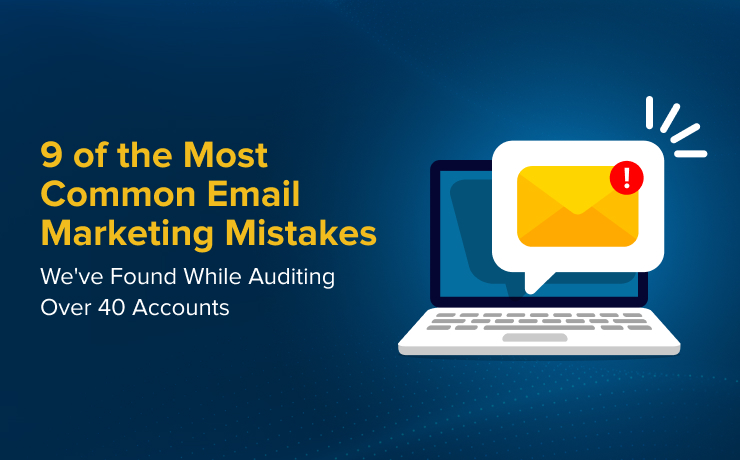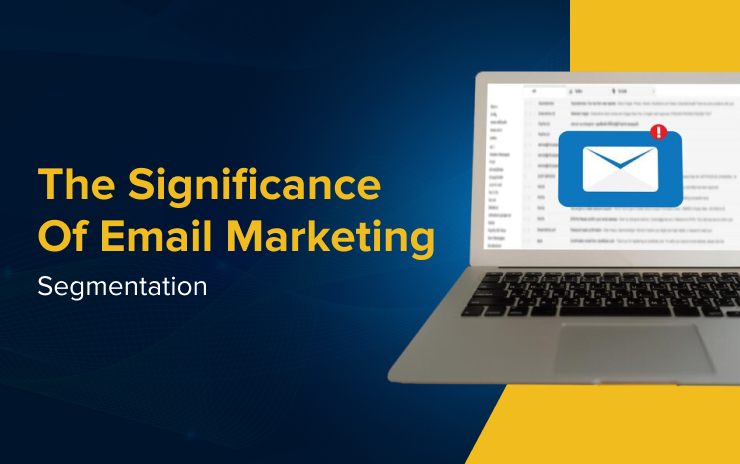9 of the Most Common Email Marketing Mistakes We’ve Found While Auditing Over 40 Accounts

Ashley Ismailovski
Director of Email Marketing

As someone who has led a team of Email Marketing Specialists and completed dozens of email marketing account audits, I’ve seen it all. Some mistakes are minor tweaks, while others are glaring oversights that can significantly impact performance. If you’re struggling with low open rates, poor click-through rates, or high unsubscribe rates, chances are you might be making one (or more) of these common mistakes. Let’s break down the top nine email marketing mistakes I’ve encountered during my audits—and how you can fix them.
1. Not Using Segmentation
One of the most common and costly mistakes I see is the lack of segmentation. Far too often, businesses send the same email to their entire subscriber base. This “batch-and-blast” approach might save time, but it comes at the expense of relevance and engagement.
Why It’s a Problem
Not every subscriber is at the same stage in their journey. A first-time visitor doesn’t need the same messaging as a loyal, repeat customer. Sending irrelevant emails can lead to high unsubscribe rates, lower engagement, and even deliverability issues.
How to Fix It
Start by creating audience segments based on behavior, purchase history, or demographic data. For example:
- A segment for new subscribers to receive a welcome email series.
- A segment for repeat customers to receive exclusive offers or VIP rewards.
- A segment for inactive users to receive win-back campaigns.
The more personalized your messaging, the more likely your subscribers are to engage.
2. Not Properly Collecting Consent from Subscribers
This one is critical—not just for compliance but also for trust. Sending emails or SMS messages without proper consent can harm your brand reputation and ultimately land you in legal trouble.
Why It’s a Problem
Without explicit consent, you risk violating laws like GDPR, CCPA, or CAN-SPAM. Beyond the legal implications, unsolicited emails often get flagged as spam, hurting your sender reputation.
How to Fix It
- Use double opt-in for email subscriptions to ensure subscribers genuinely want to hear from you.
- For SMS, include clear terms and conditions when collecting phone numbers, and ensure users understand they’re opting in to receive messages.
- Always provide an easy way for subscribers to opt out.
3. Not Optimizing Your Calls-to-Action (CTAs)
Your email can have amazing content, but if your CTA doesn’t grab attention, you’re leaving conversions on the table. I’ve reviewed countless emails where the CTA is buried, vague, or uninspiring.
Why It’s a Problem
A weak or hard-to-find CTA confuses readers and reduces the chances they’ll take the desired action. The result? Lower click-through rates and missed opportunities.
How to Fix It
- Make your CTA buttons clear, prominent, and action-oriented. For example, instead of “Learn More,” try “Shop the Collection” or “Redeem Your Discount.”
- Use contrasting colors to make the CTA stand out.
- Repeat your CTA in different sections of the email, especially above the fold and at the end.
4. Not Running A/B Tests
I can’t stress this enough: A/B testing is essential for improving your email marketing performance. Yet, many accounts I audit are not taking advantage of this powerful tool.
Why It’s a Problem
Without A/B testing, you’re relying on guesswork. Are your subject lines resonating? Are your CTAs effective? You won’t know unless you test.
How to Fix It
- Start simple: A/B test subject lines or CTA text.
- Expand to testing email designs, send times, or offers.
- Review the results and use the insights to optimize future campaigns.
A/B testing isn’t a one-and-done process—it’s an ongoing effort to refine your strategy.
5. Not Using Flows
Flows (or automations) are a game-changer in email marketing, yet so many accounts I review aren’t leveraging them. Flows save time, nurture leads, and drive conversions on autopilot.
Why It’s a Problem
Without flows, you’re missing out on consistent engagement. You’re also likely spending too much time manually sending emails that could easily be automated.
How to Fix It
Implement key flows, such as:
- Welcome Series: Introduce new subscribers to your brand and set expectations.
- Abandoned Cart Flow: Recover lost sales by reminding users of items they left behind.
- Post-Purchase Flow: Thank customers, suggest complementary products, and encourage reviews.
- Win-Back Flow: Re-engage inactive subscribers with a compelling offer.
6. Not Authenticating Your Sending Domain
This one is technical but incredibly important. If your sending domain isn’t authenticated, your emails might end up in spam folders—or not be delivered at all.
Why It’s a Problem
Unauthenticated domains raise red flags for email inbox providers. They can also make your emails more vulnerable to spoofing and phishing attacks.
How to Fix It
- Set up SPF, DKIM, and DMARC records for your domain. These protocols verify that you’re authorized to send emails from your domain.
- Work with your email service provider (ESP) or IT team to ensure proper setup.
7. Not Doing Regular List Cleaning
A bloated email list isn’t just costly—it’s harmful. Many accounts I audit have outdated or inactive subscribers that drag down deliverability metrics.
Why It’s a Problem
Sending to unengaged or invalid email addresses increases bounce rates and decreases sender reputation. Over time, this can cause your emails to land in spam.
How to Fix It
- Regularly clean your list by removing invalid or unengaged subscribers.
- Use re-engagement campaigns to win back inactive users before removing them.
- Implement a sunset policy for subscribers who haven’t engaged in 6–12 months.
8. Not Using Personalization
Generic emails don’t cut it anymore. If you’re not using personalization, you’re missing a huge opportunity to connect with your audience.
Why It’s a Problem
Personalized emails generate higher open rates, click-through rates, and conversions. Without personalization, your emails feel impersonal and less relevant.
How to Fix It
- Start with simple personalization, like including the subscriber’s name in the subject line or email body.
- Use dynamic content to tailor recommendations, offers, or messaging based on the subscriber’s behavior or preferences.
- Leverage data to create hyper-targeted campaigns (e.g., “We saw you browsing our [product category]!”).
9. Not Having a Clear Campaign Schedule
Many accounts I review lack a consistent or strategic approach to email campaigns. This leads to erratic sends and missed opportunities.
Why It’s a Problem
Inconsistent sending confuses subscribers and disrupts engagement. On the other hand, over-sending can lead to high unsubscribe rates.
How to fix it
- Plan your campaigns with a content calendar. Outline key dates, promotions, and themes for each email.
- Use analytics to identify the best send times for your audience.
- Balance your sends to maintain engagement without overwhelming your subscribers.
Email marketing is one of the most powerful tools in your digital arsenal—when done right. By avoiding these nine common mistakes, you can boost engagement, improve deliverability, and drive better results. Remember, even small tweaks can lead to big improvements over time.
Need Help Addressing These Common Mistakes?
If you’re unsure where to start or need help optimizing your strategy, don’t hesitate to contact us at SmartSites. After auditing dozens of accounts, I can confidently say that most issues are fixable with the right approach. Let’s turn your email marketing into a revenue-driving machine!
 Free
Consultation
Free
Consultation Free
Google Ads Audit
Free
Google Ads Audit







